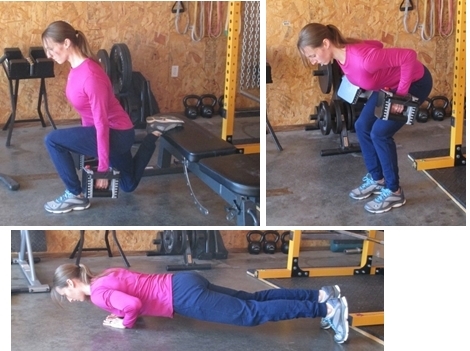 There’s no shortage of different ways to organize a strength training routine.
There’s no shortage of different ways to organize a strength training routine.
But time and time again I go back to one of my favorite templates with many of my clients, and even my personal workouts.
I revert back to this template because it’s simple, yet allows for a lot of variety – it can be used with success whether you want to get stronger, lose fat, build muscle, or just reap the many incredible benefits strength training provides.
What is it? The triple-exercise total body workout template.
Let’s look at the bare-bones template first, and then you’ll see several variations and some sample workouts.
Triple-Exercise Workout Template:
- Lower body exercise
- Upper body push
- Upper body pull
That’s the triple-exercise total body template. Pretty, isn’t it?
The template may only include three exercises, but, as the name implies, you’ll work your entire body. See an example of this in the above photo: I’m doing a rear foot elevated split squat (lower body exercise), bent over double dumbbell row (upper body pull), and very close grip push-ups (upper body push).
To ensure the triple-exercise workouts are properly balanced (meaning you work the main planes of movement and muscle groups) I like to break it down further into two templates.
Template 1
- Lower body quad dominant exercise (e.g. goblet squat, lunge)
- Upper body vertical push (e.g. dumbbell/barbell shoulder press)
- Upper body vertical pull (e.g. chin-up, pulldown)
Template 2
- Lower body hip/posterior chain exercise (e.g. RDL, swings)
- Upper body horizontal push (e.g. push-up, dumbbell/barbell bench press)
- Upper body horizontal pull (e.g. dumbbell row, inverted row)
Those two templates work the main planes of movement and hit every muscle in your body over the course of two workouts. Now, there is some overlap (for example, squats or lunges in Template 1 will work your glutes and hamstrings as will the lower body hip/posterior chain exercise in Template 2) but I prefer to include those six main movements for balance.
Built-in Versatility
These templates are incredibly versatile and can be used no matter what equipment you have.
BODYWEIGHT-ONLY WORKOUTS
Want to work out exclusively with your bodyweight? No problem! Here’s how you could put together your own triple-exercise workouts using the two templates above:
Workout 1
- 1a) Single leg squat to a box
- 1b) Handstand push-up variation
- 1c) Chin-up variation
I recommend performing this workout as a circuit. Perform each exercise one-after-the-other for three to six circuits.
Workout 2
- 1a) Single leg glute bridge/hip thrust
- 1b) Push-up variation
- 1c) Inverted row
Again, perform this workout as a circuit for three to six rounds.
With those two bodyweight-only workouts, you can train anywhere, anytime.
GYM WORKOUTS
Perhaps you work out at a gym that has barbells and dumbbells. Here’s how you could set up your program using the sample triple-exercise templates.
Workout 1
For this workout I suggest performing all of the squat sets on their own. Then perform the last two (2a and 2b) as a superset (perform them back-and-forth).
Workout 2
- 1) Deadlift variation (RDL, rack pull, etc)
- 2a) Dumbbell bench press
- 2b) One arm dumbbell row
For this workout perform all of the deadlift sets on their own. Then perform the last two as a superset.
COMBO-WORKOUTS!
This is perfect for people who can only make it to the gym 1-2 times per week – combine the bodyweight-only and gym workout templates above.
As an example, let’s say you can only (or only want to!) go to the gym twice per week. You could perform two workouts at the gym and one at home for a total of three workouts per week. For the sake of the example, let’s say you want to work out at the gym on Mondays and Fridays.
Week 1
- Mon – Gym Workout 1
- Wed – Bodyweight Workout 1
- Fri – Gym Workout 2
Week 2
- Mon – Gym Workout 1
- Wed – Bodyweight Workout 2
- Fri – Gym Workout 2
That’s just an example and you could rotate the workouts however you choose. The options are limitless.
What About Sets & Reps?
Use multiple sets and rep variations and reap the benefits they all have to offer. Two of my favorites are:
- 4 x 6 (4 sets, 6 reps each set)
- 3 x 10-12 (3 sets, 10-12 reps per set)
I like both of those set and rep schemes because they allow you to focus more on strength (with the 4×6) and also what I call more “general fitness” (3×10-12) but some would also say that set and rep set-up is good for building muscle.
You could alternate those two set and rep schemes every workout. For example, the first time you perform Workout 1 (from any of the sample workouts above) perform 4×6 for each exercise. The second time perform 3×10-12. Keep alternating back-and-forth to reap the benefits from both set and rep variations, and for variety.
And remember – improve your performance, gradually, when possible. You can accomplish this by performing more reps with the same weight (progressing from 4×6 to 4×8 with the same weight) or gradually adding more weight (e.g. start at 45 pounds for 4×6 and progress to 50 pounds for 4×6). Or, in the case of bodyweight exercises, progress to more challenging variations (e.g. progress from traditional push-ups to close grip or feet elevated push-ups).
It doesn’t really matter how you do it, but getting stronger is necessary if you want to keep getting results. It’s also fun.
Want a Done-For-You 10 Week Program That Uses the Triple-Exercise Method? If you’re interested in the triple-exercise templates shown above and would like a done-for-you program that includes exercise demonstration videos, workout logs, and tells you exactly when and how to improve your performance, then click here to check out the 3x3x3 Program.